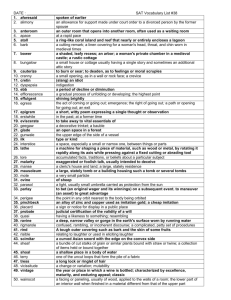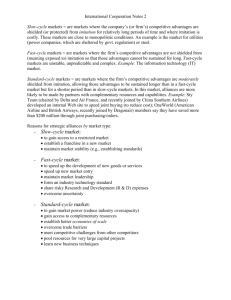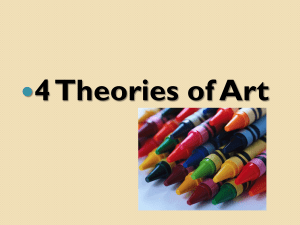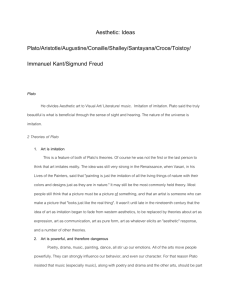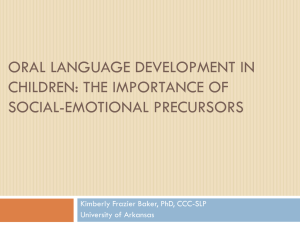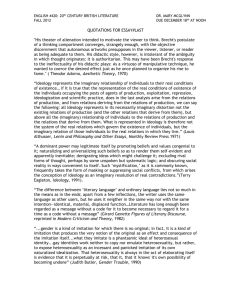Paper Template for ISCCC 2009
advertisement
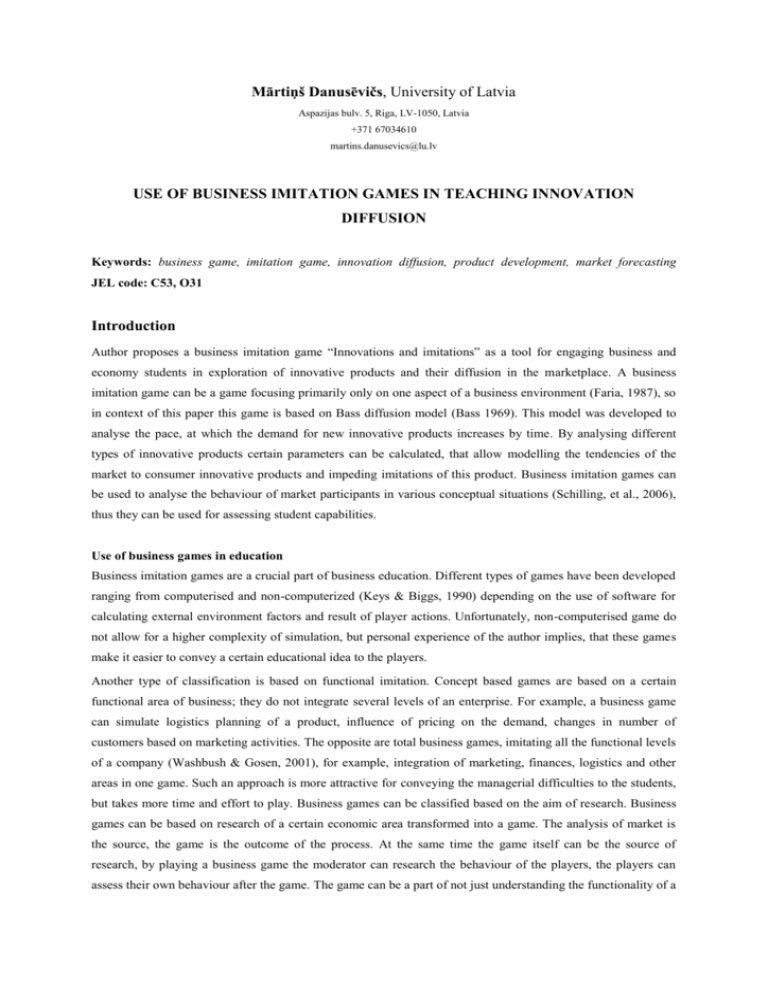
Mārtiņš Danusēvičs, University of Latvia Aspazijas bulv. 5, Riga, LV-1050, Latvia +371 67034610 martins.danusevics@lu.lv USE OF BUSINESS IMITATION GAMES IN TEACHING INNOVATION DIFFUSION Keywords: business game, imitation game, innovation diffusion, product development, market forecasting JEL code: C53, O31 Introduction Author proposes a business imitation game “Innovations and imitations” as a tool for engaging business and economy students in exploration of innovative products and their diffusion in the marketplace. A business imitation game can be a game focusing primarily only on one aspect of a business environment (Faria, 1987), so in context of this paper this game is based on Bass diffusion model (Bass 1969). This model was developed to analyse the pace, at which the demand for new innovative products increases by time. By analysing different types of innovative products certain parameters can be calculated, that allow modelling the tendencies of the market to consumer innovative products and impeding imitations of this product. Business imitation games can be used to analyse the behaviour of market participants in various conceptual situations (Schilling, et al., 2006), thus they can be used for assessing student capabilities. Use of business games in education Business imitation games are a crucial part of business education. Different types of games have been developed ranging from computerised and non-computerized (Keys & Biggs, 1990) depending on the use of software for calculating external environment factors and result of player actions. Unfortunately, non-computerised game do not allow for a higher complexity of simulation, but personal experience of the author implies, that these games make it easier to convey a certain educational idea to the players. Another type of classification is based on functional imitation. Concept based games are based on a certain functional area of business; they do not integrate several levels of an enterprise. For example, a business game can simulate logistics planning of a product, influence of pricing on the demand, changes in number of customers based on marketing activities. The opposite are total business games, imitating all the functional levels of a company (Washbush & Gosen, 2001), for example, integration of marketing, finances, logistics and other areas in one game. Such an approach is more attractive for conveying the managerial difficulties to the students, but takes more time and effort to play. Business games can be classified based on the aim of research. Business games can be based on research of a certain economic area transformed into a game. The analysis of market is the source, the game is the outcome of the process. At the same time the game itself can be the source of research, by playing a business game the moderator can research the behaviour of the players, the players can assess their own behaviour after the game. The game can be a part of not just understanding the functionality of a certain economic area, but also as a tool for researching the behaviour of the participants themselves. Business simulation games can be likened to management laboratories, a tool for behavioural experimentation (Wolfe & Castrovanni, 2006). Additional realism can be added to business simulation games by adding seasonal and cyclic fluctuations. Simulation games can include the four marketing mix elements, use of the product (4P – product), facilitating the recognition and advertisement, price effect (4P – price) on performance characteristics. In games including price elasticity, assuming other factors being equal, the price changes affect the sales volume. Sometimes this influence can be non-linear. Marketing mix element – the placement, is used less frequently in simulation games (4P – place), since it is usually not so easy to imitate. The promotion of products (4P – promotion) sometimes is used in the form of possibility to use different marketing campaigns to simulate the correlation between increased marketing costs and revenues. Simulation games are not usually defined with market variations. Simulation games are widely used in the management of other aspects, such as manufacturing, logistics, finance, research and development. Business imitation game “Innovations and imitations” is a concept game concentrating on demand forecasting for new products. Since the business game uses calculations to determine the total demand for products, it is a computer based business game. Bass model This game is based on the Bass diffusion model develop by Frank Bass since in 1963 and developed in numerous publication in following years. It was inspired by the concept of word-of-mouth impact on bolstering demand for a new product. The model is partially based on the concept that probability of adoption of a new product is functionally tied to number of consumers, who have already adopted the new product. In his work Bass envisioned the innovators and imitators as consumers. Innovators are the first, who start using the new product. Later on imitators are imitating the behaviour of the primary group – the early adopters of the product. In the game “Innovations and imitations” the imitation term shouldn’t be mistaken for the same concept used by Bass. It is used as a competing product providing an imitation of the original product. Game concept The game is currently called “Innovations and imitations”, and uses Bass diffusion model as a base tool for calculating market demand for innovative and imitation product. The game principle is based on introduction of 2-3 innovative products to the market. The students, participating in the game, usually form teams that significantly outnumber the number of innovative products. As a result, only one team can produce an innovative product, which results in the rest of the team to perform the role of imitators. Every year is played as a turn, a typical game can consist of 6-10 years. Each turn teams have to decide what type of products they are going to produce. After production decisions have been met and production expenses covered, the total demand for the year is made publicly known. Every team calculates amount of product sold depending on available demand and number of teams competing for the same product. Demand is split proportionally between teams producing the same product. Any produce left over is disregarded as not sold and can’t be sold on following years. Each year teams can change the product line they are producing, thus reacting to the changes in market demand and competition. The ultimate goal of the game is to have a higher bank balance at the end of the game. Value of assets, patents, production surplus is not taken into account. Game mechanics Business simulation game “Innovations and imitations” is a computerised game, that uses the software only for providing relevant information for the players. The teams do not require a computer to make their decisions and perform their tasks. Depending on the previous experience of the players, they can calculate their financial balance themselves or use the output of the program. Up to 10 teams can be participating in the game. A higher number of teams results in decreased income for each team, making the game less appealing. The number of teams should be at least the double of innovative products used in the game. It is important to provide at least two teams per product plus one additional team. The reason for this proportion is to ensure that every product has at least one team to produce the imitation of it and an extra team to provide competition in any of those markets. If the number of teams will be lower, the game will lose attractiveness to the players because of lack of competitive tension. A virtual market is prepared for the game, characterised by a certain population of customers, who could be interested in consuming the new product. The population can be constant, but a random cyclical change of population can be generated, to simulate a more realistic situation. Game moderator announces the approximate number of the total population to encourage the players to estimate the possible distribution of demand for the gameplay. The moderator of the game prepares 2-3 innovative products as patents to be purchased. Only one team can purchase a certain patent granting them unique rights to produce products of that certain type. The patents are sold in an auction. Different types of auctions can be used, as English auction, Dutch auction or sealed first-price auction. Since there will be teams not capable of purchasing a patent, those teams are forced to produce imitations of any of the innovative products. Each product has certain characteristics – ease of imitation, demand growth, retail price, first year demand assessment, production costs. Ease of imitation represents the speed of imitators gaining market shares. In the context of Bass model it is used as the parameters p. Biological or medical products should have a lower ease of imitation, as opposed to financial or ITT products. Demand growth represents the speed, at which the total demand for the products reaches the saturation point. Products with a lower demand growth are suitable for a more long-term strategy and vice versa. First year demand is based on the results provided by the model. It is recommended to randomly increase or decrease this number by 10%, to illustrate the possible margin of error in surveying customers for their willingness to buy a new product. Each product has fixed and variable production costs. The total demand for each product type is calculated as follows: where, TDkt – total demand for product k on year t; Pt – population in year t; NPDkt – new product demand share of product k on year t, based on Bass model and random noise. The result imitates an increase in the number customers, who are willing to purchase each product. For products with slow demand growth is steadier, a stable number of customers can be predicted. If the product has a fast demand growth, it imitates products that gain their popularity peak very fast – in a year or two. After that the demand for the product declines steadily. During the game products with different characteristics are offered, to foster student understanding of different levels of innovation diffusion. An example, as seen in figure 1, illustrates a product with slow demand growth and medium demand for imitation. Fig. 1. Modelled random dynamics of demand for a product with low ease of imitation and slow demand growth The total demand behaves differently for each type of product used in the game. This is implemented to illustrate different innovation diffusion for electronics, household goods, services or other types of products. The share of customers willing to buy the new product of a certain type is calculated using the model proposed by Bass with addition of random noise, to simulate random events similar to real-life situations: where, p – innovation coefficient; q – imitation coefficient; R – random number in a predefined range. The parameters p and q can be calibrated to illustrate a typical behaviour of innovation diffusion for different products. Typical ranges used in games by author varies between 0,05 and 0,20 for parameter p and between 0,3 and 0,6 for parameter q. Where, ImDkct – total demand for imitation of product k on year t to company c; Ikt – imitation rate of product k on year t, based on a normal distribution with a pre-set range of imitation share and growth rate; The mean and standard deviation in the normal distribution is chosen to illustrate the kurtosis of demand growth for imitative products; nkt – number of companies producing product k on year t. On a typical game author uses imitation of a biological product, financial product and ITT product. These products have different tempos of innovation diffusion (Figure 2). It allows students to concentrate on different strategies, based on their preferences or intuition. Fig. 2. Modelled random total demand for three innovative products The demand for the BIO product is modelled with a low ease of imitation and slow demand growth. This product is a long term investment and is mostly profitable throughout the game. FIN product has a high ease of imitation and medium demand growth. As a result this product is most attractive for imitators. This results in high competition and a seeming advantage becomes a disadvantage, teaching the students to be vary of popular markets. The third product – ITT, has a medium ease of imitation and a fast demand growth. This product peaks on the first year, and the demand is declining for the rest of the game. An important part of the game mechanics are the imitations. Unlike innovative products available only to the owners of patents, any team can produce any type of imitation, competing with other imitators in the market. This makes being an imitator a more challenging task. To compensate for the increased risk, imitations are cheaper to produce (50% lower costs), and their retail price is only a little bit lower (10% price decrease). This makes producing imitations more profitable than producing innovation, if initial investment of purchasing a patent is not taken into account. Fig. 3. Modelled random demand for three imitations of innovative products The demand growth is unknown to the players until the specific year is played as a turn. Each team must plan their production orders in advance. It leaves the teams with a risk of overproduction, leading to extra costs and useless goods, or shortage of produce, causing lost income. The game usually ends at a previously defined year. To make a game more complex and to allow students to reapply their newly gained knowledge, a game of several cycles can be played. The moderator of the game can introduce new patents in the middle of the game. For example, an electronic product patent can be bought on year 6. Since students have become familiar with the mechanics of the game, they will have a change to correct their strategies on second innovation cycle. Learning outcome and application of the game The game has been a success in increasing student awareness of new product market development. It has been played in Latvia with High school pupils, students in Bachelor and Master economic and business management programs. The game is flexible enough to be adapted for players with different skills and knowledge. A more analytical approach can be used with MBA students by introducing an economic forecasting element. Also, from the point of view of academic didactics in the process of studying business administration sciences, these simulation games have an even increasing importance. In modern study process the perspective is gradually changing from a lecturer-oriented to student-oriented process (Garris, et al., 2002). The business simulation games are perfectly suited for this new approach. A typical game-play is characterised by three phases. The first phase is the initial fight for the innovation products. In this phase players of the business game get familiar with initial planning and decision making in a situation of imperfect information. The most typical reaction is overestimation of future income and increased spending on initial investment, usually leading to a disadvantageous economic position. Some teams learn to overcome this burden by selling the patent to other team at an advantageous price, in the same time learning bargaining skills. Table 1. Typical yearly profit for different product types excl. investment, EUR Year 1 Year 2 Year 3 Year 4 Year 5 Year 6 Year 7 Year 8 Year 9 Year 10 Product with slow demand growth and low ease of imitation Innovators Imitators 60 345 48 884 57 956 50 373 55 632 38 058 27 076 26 901 8 690 8 669 -10 000 9 618 23 410 32 828 51 508 49 185 46 450 52 508 30 667 31 964 59 738 29 360 16 245 6 730 -1 079 94 917 63 817 47 462 31 226 15 149 Product with medium demand growth and high ease of imitation Innovators Imitators 269 023 190 927 178 297 150 699 110 873 -5 000 65 086 96 391 121 978 127 665 Product with fast demand growth and medium ease of imitation Innovators 353 911 239 429 119 336 41 939 -4 106 -18 279 -26 206 -27 923 -29 280 -29 659 Imitators -15 000 142 167 118 014 78 639 31 648 12 316 -4 384 -8 489 -12 600 -13 829 The second phase is characterised by increased activity of imitators. Typically majority of teams imitate the product with the fastest demand growth. This results in high competition in one type of products and low competition in less demanded product markets. As a result teams working in lower competition gain higher income than teams, who choose high demand, high competition markets. As can be seen in the summary of expectable profits in table 1, there are products that become unprofitable in the middle of the game. It is important for players to notice this tendency, even if the increase in the number of customers demanding the product appears to be still satisfactory. Third phase is a stabilising phase, when teams split the market in similar groups whether by self-management or mutual agreement. This phase demonstrates the ability of the groups to communicate between teams with different interests. Fig. 4. Summary of team profit from seven business game runs Learning outcome can be divided into three primary areas. Widest area is the promotion of economic analysis skills. Students have to forecast the market demand based on the limited information available. In this game quantitative forecasting is useless, since there is very limited amount of data available. So students have to use the concepts of innovation diffusion, to assess the market size, demand growth and the expectable point of market saturation. Another area of economic analysis is planing of cash flow. Since teams are competing in an auction for patents, they have to calculate the expectable income, to determine the highest bid, that is economicaly feasible. Second area of learning outcomes is competion analysis. Students need to understand behaviour of competitors and predict their future moves. Since companies in the business game can change their poduction lines, it is advantegous to produce a product line with lowest market saturation (so lowest competion level). This area is closely coupled with the third area of learning outcomes – improve communication skills. Diminshing returns ir year 2 and 3 of the game force the teams to start communicating. When teams understand the trends of the leading products, competition in certain in certain product markets increases signicifally. So teams have to find a way to partion the market, to maximise the profit or avoid further losses. In most cases the teams are not capable of doing so. Such a result is even advantegous, since it allows the game moderator to illustrate the lack of selfregulation and the resulting income loss for all teams. Sometimes teams can be tought, that the best strategy is that of doing nothing. Post-game analysis performed by players of the business game show increased understanding of market behaviour. Students usually recognize the complexity of making business in risky environment, mostly by mentioning lack of clear thinking and overtly high spending at the beginning of the game. Common lessons learned by students in their post-game analysis: Overbidding in the initial auction for patents. Income later gained by producting the respective goods didn’t cover the expenses of buying the right of producing these products. Following mass histeria. Switching to producing of most demanded goods resulted in high competition. Manufacturing too much products. Increased manufacturing costs and a unproportionally high share of fixed costs per unit Adding post-game analysis and integrating the results of the game in further learning of topics linked to demand forecasting has been observed as a valuable addition to the study process. Conclusions 1. Business imitation games are a modern, important tool for use in business education. They provide a platform for conveying theoritical concepts and market data to students in a competitive environment 2. Bass model is a very appropriate concept to be used in a computerised imitation game, since it is based on market growth, it can be calibrated to simulate certain product groups. 3. Business imitation game “Innovators and imitators” shows an average loss at year 5 for innovators and year 7 for imitators of fast demang growth and medium ease of imitation. Students can be challenged to avoid losses by cooperating in the virtual marketplace. 4. Previous games result in a average time of return on investments of 3 years, at the same type more than half of teams use to stay with a negative balance for the duration of the game. This result can be used for further post-game analysis. Summary The business imitation game “Innovations and imitations” is a convenient way of conveing the principles of uncertain demand for new, innovative products, to students of business and economic programms. It is a convenient tool for teaching in courses spanning topics such as business model development, innovation methods, market analysis, forecasting methods and other. Experience in the University of Latvia has shown increased interest of students in topics of demand forecasting and innovation difusion following game sessions of “Innovators and imitations”. The game in its current form is based on a generated market growth by Bass model. Moderators of the game can calibrate the main indicators such as market size, growth rate, adoption rate. Market shares are modelled depending on the behaviour of the players. Increased competions results in loses for everybody, leading to an understanding of market forces and need for cooperation amongst students. Further developments of the game should include use of past cases of difusion on different real-life innovations, to add increased realism to the game. Bibliography 1. 2. 3. 4. Bass, Frank, A new product growth model for consumer durables., 1969. Management Science 15 (5): p215–227 Faria, A. J., 1987. A survey of the use of business games in academia and business. Simulation & Games, Volume 18, pp. 207-224. Garris, R., Ahlers, R. & Driskell, J. E., 2002. Games, Motivation, and Learning. Simulation & Gaming , 33(4), pp. 441-467. Schilling, M. S., Mulford, M. A. & Geiger, I. R., 2006. Collective bargaining as a two-level game: Direct learner-expert interactions. Simulation & Gaming, 37(3), pp. 326-338. Wolfe, J. & Castrovanni, G., 2006. Business Games as Strategic Management Laboratories. Development in Business Simulation and Experimential Learning, Volume 33, pp. 31-40.

